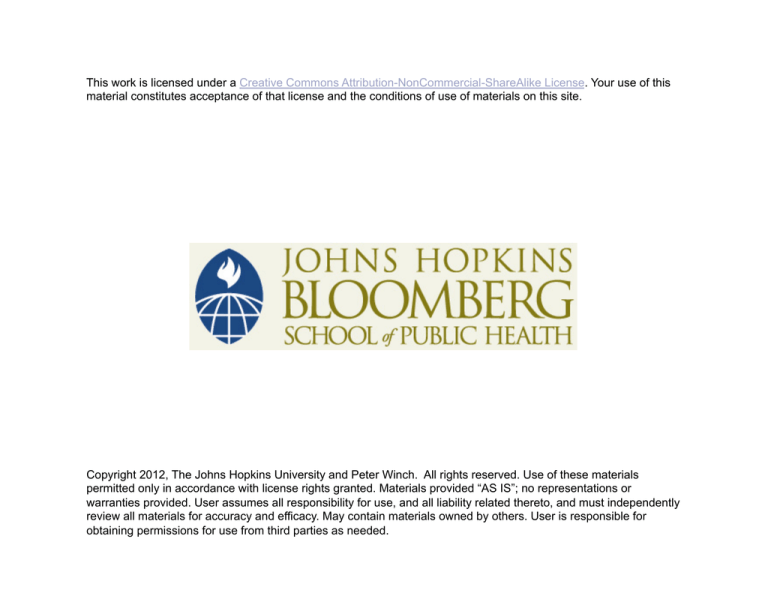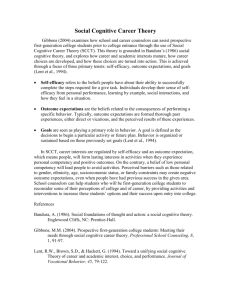
This work is licensed under a Creative Commons Attribution-NonCommercial-ShareAlike License. Your use of this
material constitutes acceptance of that license and the conditions of use of materials on this site.
Copyright 2012, The Johns Hopkins University and Peter Winch. All rights reserved. Use of these materials
permitted only in accordance with license rights granted. Materials provided “AS IS”; no representations or
warranties provided. User assumes all responsibility for use, and all liability related thereto, and must independently
review all materials for accuracy and efficacy. May contain materials owned by others. User is responsible for
obtaining permissions for use from third parties as needed.
Social Cognitive Theory
Peter Winch
Health Behavior Change at the Individual,
Household and Community Levels
224.689
Behavior change models
There are hundreds of models in the
literature
Last class we took two models as examples
that are particularly common in public
health: HBM and TRA/TPB
Many other models in the Theory At A
Glance manual, and in the literature
Models of health behavior:
HBM, TRA/TPB and others
Strengths
Make explicit thinking
about behavioral factors
Give you a checklist of
factors to consider
Can organize qualitative
or quantitative research
Provide input on
intervention content
May reassure those who
are nervous about
behavior change
Weaknesses
Suggest a linear process
with limited human
agency
Larger social and
environmental factors not
captured
Largely etic, don’t take
into account local terms
and concepts
Significance of Health Belief Model
Indicated that we could analyze systematically
why people do or do not accept public health
interventions
Promoted the idea of planning of educational
interventions
Indicated how we might intervene
– if perceived susceptibility low, explain to
people why they are susceptible
Lessons from flossing survey:
– Knowledge and self-efficacy high, but low
perceived susceptibility + no cues/ reminders
– What would you recommend?
Social Cognitive Theory
Appearance of different theories
HBM
TRA/
TPB
SLT/
SCT
Social Cognitive Theory
Earliest version was Social Learning Theory
Developed by Albert Bandura
Social Cognitive Theory
Behavior
Personal Factors
(Cognitive,
affective, &
Biological events)
Environmental
Factors
Social Cognitive Theory
Difficult to fully appreciate SCT
The triangle that is always shown to
summarize SCT is not analogous to the
models for HBM and TRA/TPB, refers to
broader processes
The key difference is agency: People’s
capacity to make choices and impose those
choices on the world
Social Cognitive Theory
In some ways it is the “anti-model”
Despite all of the boxes and arrows, people
can think and act “out of the box”, are
capable of thinking and acting the way they
choose to, despite the situation being very
unfavorable toward the action
Social Cognitive Theory
“Reciprocal
Determinism”
Behavior
Personal Factors
(Cognitive,
affective, &
Biological events)
Environmental
Factors
Includes
both social
& physical
environment
Source: icddr,b. http://www.icddrb.org/
Source: icddr,b. http://www.icddrb.org/
Behavior
Personal Factors
(Cognitive, affective, &
Biological events)
Environmental Factors
Behavior
Personal Factors
(Cognitive, affective, &
Biological events)
Environmental Factors
18 April 2010
Source: icddr,b. http://www.icddrb.org/
Behavior
Personal Factors
(Cognitive, affective, &
Biological events)
Environmental Factors
Need to be
changed only
new drum pic.
Source: icddr,b. http://www.icddrb.org/
Behavior
Personal Factors
(Cognitive, affective, &
Biological events)
Environmental Factors
Source: icddr,b. http://www.icddrb.org/
Behavior
Personal Factors
(Cognitive, affective, &
Biological events)
Environmental Factors
Source: icddr,b. http://www.icddrb.org/
Behavior
Personal Factors
(Cognitive, affective, &
Biological events)
Environmental Factors
“Agency” a key theme
Agency – “The means or mode of acting;
instrumentality”
– That is, “the power to act”... “Acts done
intentionally”
Collective agency also a theme
– That our power to act is strongly
mediated by our shared beliefs
– As well working collectively on the basis
of shared beliefs is a powerful force for
change
Agency in HBM and SCT
Limited agency
More agency
HBM: If perceived
SCT: Despite low
susceptibility is low,
perceived
behavior seen as
susceptibility, low
difficult, person very
feasibility, based on
unlikely to practice the
observation of others
behavior
and the environment,
person may make
decision to practice
the behavior
Self-efficacy
A cornerstone of Social Cognitive Theory
Belief/conviction (may or may not be true)
that one has the power to act in a certain
manner to achieve specific goals/outcomes
Distinct from self-esteem, one’s feelings of
self-worth
A person with low self-efficacy in relation to
behavior X may have high or low selfesteem
Measurement of self-efficacy
Measured through a series of statements:
– “I feel confident I can refuse a cigarette
when my peers offer one to me”
– “I feel confident that I can ask my
partner whether she agrees to us using
a condom”
Examples of response categories:
– Strongly disagree, disagree, neutral,
agree, strongly agree
– Not at all confident, a little confident,
confident, very confident
Factors increasing self-efficacy
Experience carrying out the behavior,
“mastery experience” e.g. previous refusal
of cigarettes offered by peers
Modeling of behavior by others / vicarious
experience
Encouragement/mentoring by others to
carry out the behavior
Experience with overcoming constraints to
practicing the behavior
Self-efficacy
Popular concept, has been incorporated
into many different models and frameworks
Bandura and others feel self-efficacy
doesn’t make as much sense when it isn’t
“at home” in Social Cognitive Theory
Explain this:
Lasagna
Selfefficacy
Italian
cuisine
Social
cognitive
theory
SCT especially applicable where
self-control is needed
Self control required in refusal to:
– Smoke cigarette when offered by peer
– Have sexual intercourse/have sexual
intercourse without a condom
– Have multiple sexual partners
– Have large family
– Eat everything on the dinner plate
– Eat snacks when offered
Overview: Individual-level models
of health behavior
Intuitive/Ease of
understanding
Heuristic device
HBM
TRA/TPB
SLT/SCT
Is it a theoretical
Not
Not quite
perspective?
quite
Disease focus
Popularity of the
model/theory
Many would
say yes
SCT
Self-Eff
PubMed hits for terms in title
Health Belief Model
217
Theory of Reasoned Action
63
Theory of Planned Behavior
214
Social Learning Theory
40
Social Cognitive Theory
66
Self-efficacy
2191
Markus & Kitayama, Table 1, p 230
Markus HR, Kitayama S. Culture and the self: Implications for cognition, emotion, and motivation. Psychological Review 1991;98:224-253





